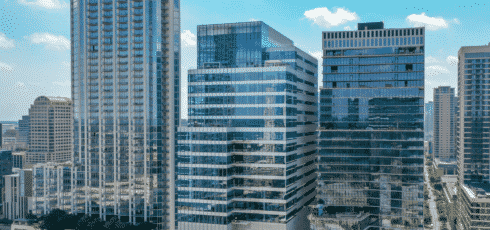This article was originally published in AQUILA’s 3Q 2018 Austin Office Market Report and will not be updated. Please contact us if you have specific questions regarding the information in this article.
The Arboretum/Domain micromarket, located in Northwest Austin is one of the most dynamic office markets in Austin.
Named after and anchored by two of Austin’s prominent retail developments – the Arboretum and the Domain – this office market has become an exciting area for leasing and development. A majority of the top Northwest office buildings, along with some of the top tenants, are located in this micromarket.
In this special report, we take a look at the histories of these two developments and how they are performing today.
Understanding Northwest Austin Arboretum/Domain Micromarket
The Arboretum/Domain micromarket represents the most central portion of Austin’s Northwest Submarket and includes the intersection of three of Austin’s busiest thoroughfares — US-183, Mopac Expressway, and Loop 360/Capital of Texas Highway.
The micromarket’s location gives it an important and unique advantage, as these three roads funnel thousands of Austinites through the micromarket every day, while also giving easy connectivity to Austin’s densest residential areas.
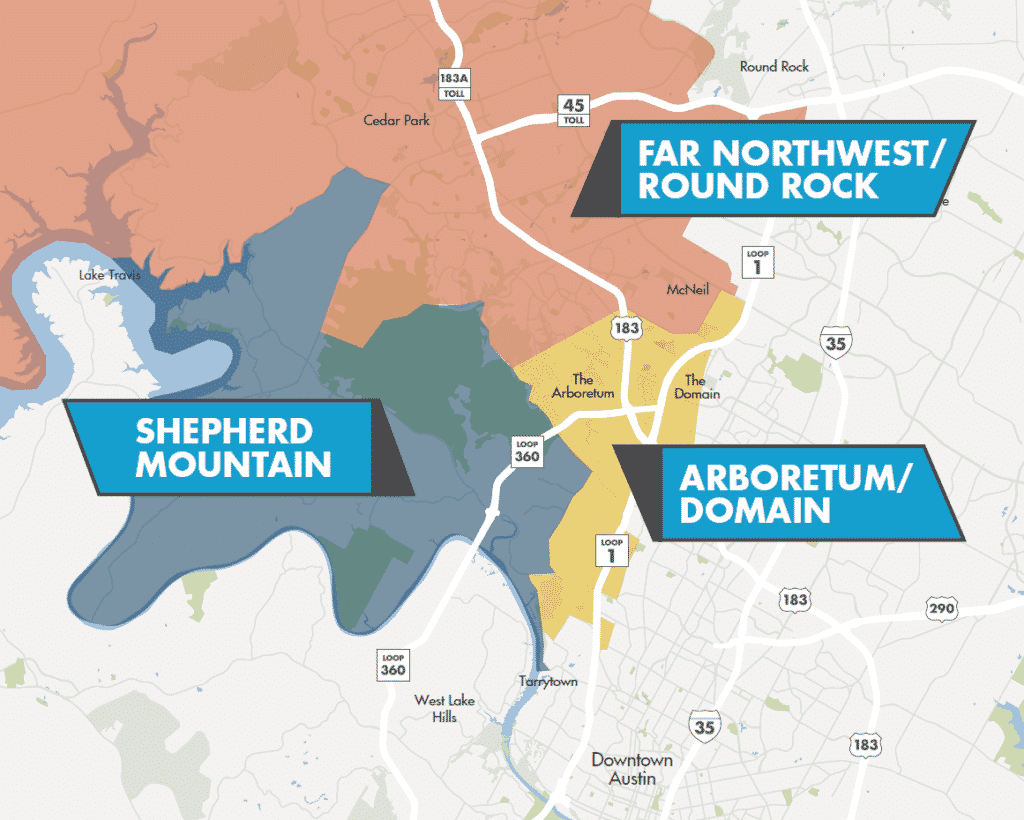
Demographic Changes in the Micromarket
Over the past decade, this micromarket has changed quite dramatically in terms of demographics. To analyze the micromarket from a demographic standpoint we used census data for the two zip codes containing The Arboretum and Domain (78758 and 78759) and compared those numbers to Austinwide averages.
Going back to 2000, 50% of households in The Arboretum/Domain area made less than $50,000 a year, and only about 16% were in the upper-income bracket of $100,000 or more. However, today that distribution has shifted, with over 50% of households now making more than $50,000 and 30% making more than $100,000 a year.
This distribution puts the 2018 median household income of The Arboretum/Domain micromarket at $61,023, up from $51,841 in 2000. This is still low compared to the CBD’s median income of $89,743, but slightly above the citywide average of $59,435.1

Along with this growth in income, there has been an increase in education. Looking at the percentage of the population 25 years or older with a Bachelor’s degree or higher, this micromarket has seen an upward trend since 2000.
Today, over 50% of residents 25 years or older have at least a Bachelor’s degree, offering a highly educated workforce for tenants choosing to office in this micromarket. This micromarket has consistently outperformed the city in this department, although that gap has begun to narrow.
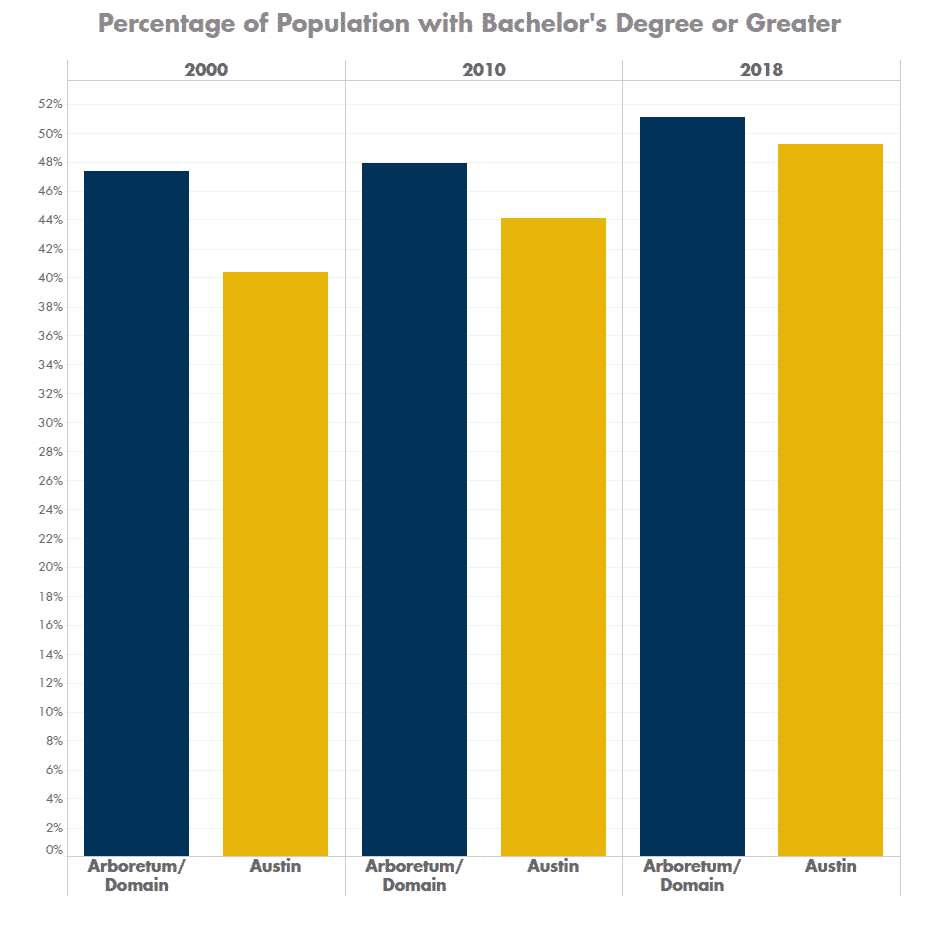
The Population Center of Austin
Over the past three decades, Northwest Austin has seen enormous growth in order to accommodate Austin’s growing population. Northwest suburbs Cedar Park and Leander, for example, have both been ranked among the top 20 fastest-growing U.S. cities.
Due to this growth, the demographic center of the city has continued to shift northwest. A 2011 study by the City of Austin used Census data to find the mean center of population in Austin, and placed it to the east of Mopac, just south of 2222. A similar study done by the City in 2000 put the population center somewhere near the UT campus, showing a continued shift northward towards The Arboretum/Domain market.

Comparison Map of Austin’s Population Center (2000 vs. 2010)
The Arboretum
Defining the Arboretum
While the actual Arboretum development is bounded by Great Hills Trail to the North and Capital of Texas Highway to the South, for the purposes of this report we have expanded these boundaries northward to Braker Lane and slightly south of Capital of Texas Highway to encompass all the office buildings considered to be part of The Arboretum market. This subset contains 19 Class A office buildings comprising 1.5 million square feet.
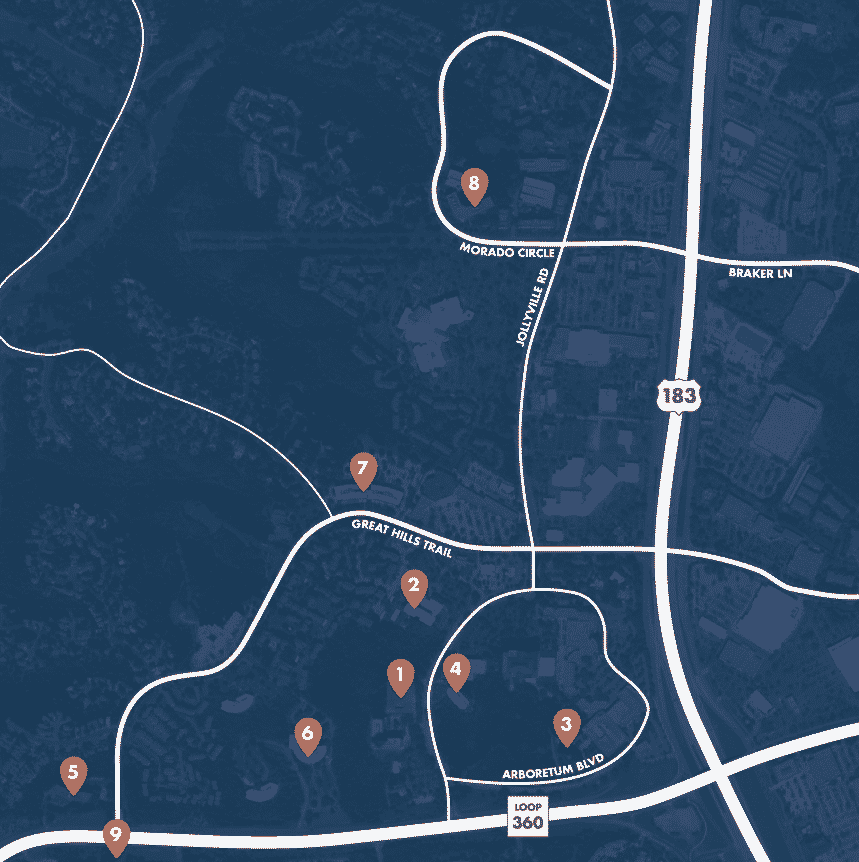
Class A Office Buildings in the Arboretum
| Building | Net Rentable Area (Square Feet) | |
| 1 | 9500 Arboretum | 182,331 |
| 2 | Arboretum Atrium | 90,280 |
| 3 | Arboretum Plaza One + Two | 245,175 |
| 4 | Arboretum Point | 150,033 |
| 5 | Colina West | 69,299 |
| 6 | Great Hills Corporate Center I – III | 176,079 |
| 7 | Great Hills Plaza | 139,252 |
| 8 | The Campus at Arboretum 1-5 | 316,875 |
| 9 | Westech 360 Bldgs 1- 4 | 175,529 |
History of The Arboretum
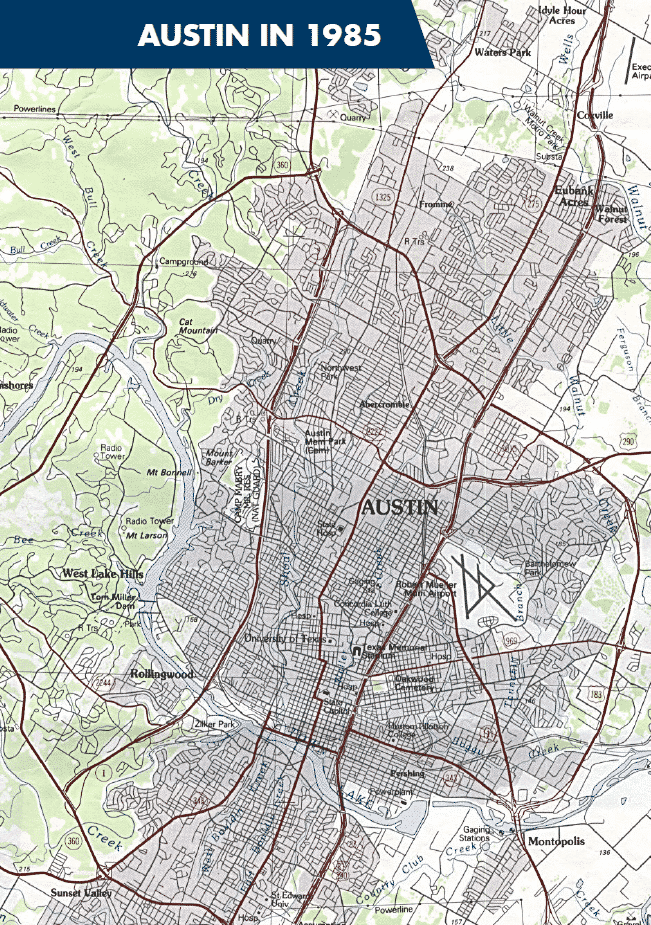
The office component, including Arboretum Plaza One and Two and Arboretum Atrium, opened in 1984. The retail, which featured a walkable, open-air mall and food court, opened in 1985. The project’s anchor, the 492-room Wyndham Hotel (now The Renaissance), opened in 1986.
Situated in a heavily wooded, park-like area, The Arboretum was unique at the time.
Opened when most retail developers were building traditional malls, The Arboretum offered a precursor to today’s popular lifestyle center concept, offering walkable retail and desirable restaurants.
“The Arboretum was really groundbreaking for Austin in a variety of ways,” says Bart Matheney, a Principal with AQUILA Commercial. “First, it was built within a grove of trees. It was one of the first developments to embrace the emerging environmental movement. At the time, you just didn’t see trees in a retail center. Second, it was one of the first developments to offer walkable amenities to office tenants. That just wasn’t a reality elsewhere in that part of town.”
In 1984, when The Arboretum opened, Loop 360 had just been extended up to US-183, and the Pennybacker Bridge had just opened a few years prior in 1982. The Arboretum was as far northwest as the major highways extended.
“The development was very well received and attracted some of the highest-end retail in Austin, as well as several key corporate clients,” remembers Matheney.
The Arboretum was a hotbed for technology clients. Dell chose Arboretum Point for its headquarters, where it grew before moving to Round Rock in 1996.
Throughout the late 1980s and into the 1990s, The Arboretum maintained its popularity as one of the prime locations in Austin to shop and lease office space.
The Arboretum, Today
Today, The Arboretum remains a popular location for Austinites and tenants alike. Complete with everything from national retailers and restaurants like The Cheesecake Factory, Pottery Barn, Gap, and Barnes & Noble to local favorites like Amy’s Ice Creams and Z’Tejas, The Arboretum has something for everyone. With vacancy rates below 10%, tenants are clearly seeing the value as well.2
Product Type
Office buildings in The Arboretum have an average of four floors, with a few outliers like Arboretum Plaza and Arboretum Point at nine floors. However, that does not mean these properties are small, as the average total rentable area is 83,000 SF.
Similar to many suburban office buildings, almost every property at The Arboretum is filled with a mix of tenants rather than fully leased to a single tenant. Office buildings in this market are also on the older end of the spectrum, with the most recent construction completed in 2001 (The Campus at Arboretum 4) and most buildings completed in the 1980s when The Arboretum was first developed. A few of these buildings have undergone renovations as well, including Arboretum Atrium renovated in 2005 and Colina West renovated in 2012.
Tenant Mix
Tenants in The Arboretum are a mix of tech and professional service companies. Many of these tenants, such as Gemalto and Rockwell Software Inc. are large, international companies that have chosen to make The Arboretum their home in Austin.
The average size of tenants in The Arboretum is 7,000 square feet, with 10 tenants occupying more than 20,000 square feet.
| Largest Tenants in The Arboretum | |
| Gemalto | 58,695 SF |
| AlcateLucent | 38,044 SF |
| Cognitive Scale | 35,751 SF |
| BMC | 34,086 SF |
| Rockwell Software Inc. | 27,642 SF |
The Domain
Defining The Domain
The boundaries of The Domain are generally considered to be Mopac to the West and North, Burnet Road to the East, and Braker Lane to the South. The Class A office buildings used in our analysis are located mostly near the outskirts of these boundaries, while the retail and multifamily properties are located closer to the core, with an especially high concentration along Domain Drive.
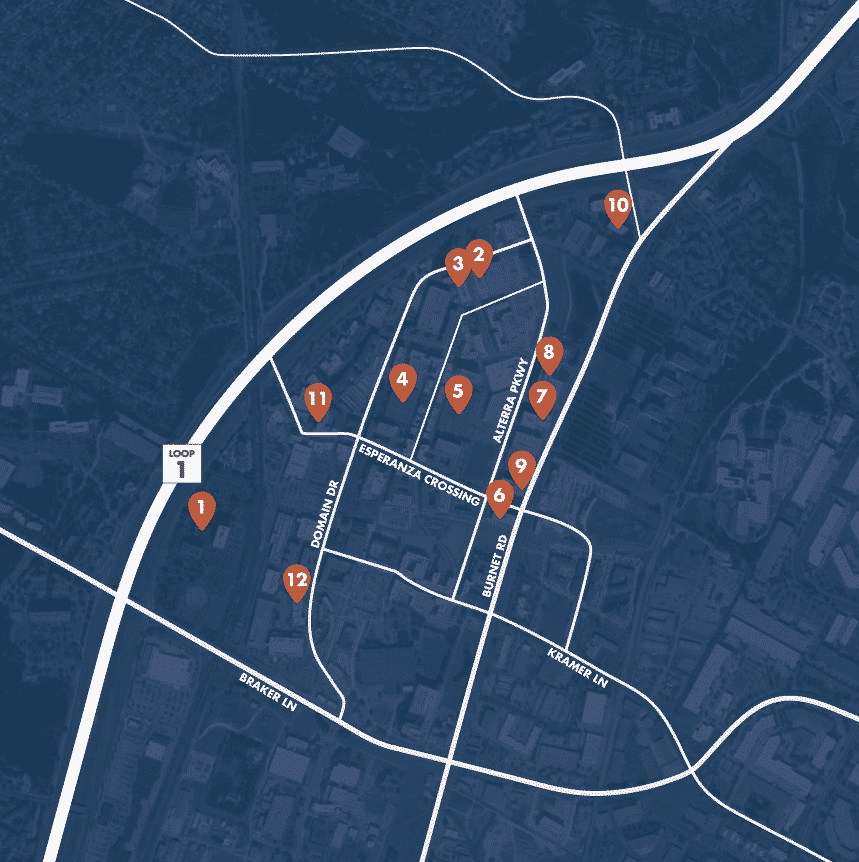
Class A Office Buildings in The Domain
| Building | Net Rentable Area (Square Feet) | |
| 1 | Braker Pointe I – III | 376,948 |
| 2 | Domain 1 | 124,571 |
| 3 | Domain 2 | 143,331 |
| 4 | Domain 3 | 179,006 |
| 5 | Domain 4 | 152,012 |
| 6 | Domain 5 | 78,987 |
| 7 | Domain 7 | 221,973 |
| 8 | Domain 8 | 290,983 |
| 9 | Domain Gateway | 173,926 |
| 10 | Domain Pointe I + II | 239,583 |
| 11 | Offices at The Domain 1 | 92,955 |
| 12 | Offices at The Domain 2 | 75,509 |
History of The Domain
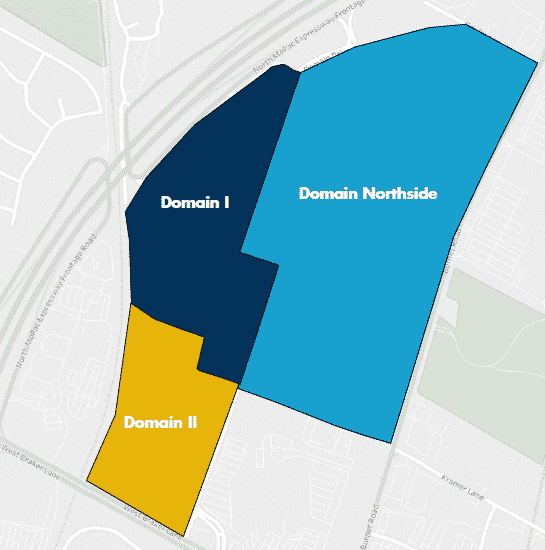
Map of The Domain
The Domain, once a 304-acre IBM campus, was developed by Endeavor Real Estate Group in partnership with Simon Property Group Inc.
In 1999, the area we now know as The Domain was purchased by Endeavor with the Blackstone Group and JER Partners providing financing. Originally intended to be a home for tech companies riding the dot-com wave, the name “Domain” was born to fit the project’s technology-focused image. The ensuing dot-com bust in 2000 quickly put an end to that plan, but the name stuck while Endeavor looked for a different type of project to pursue.
Seeing that the site still offered potential, Endeavor altered course and decided to pursue a less office-focused, mixed-use development with retail and multifamily components. The goal was to be not quite an office park, not quite a shopping mall, but rather a community where people could come to work, live and play. Endeavor eventually formed a new partnership with Simon Property Group, experts in mall development with prior experience running multiple sites in Austin, including The Arboretum.
In 2003, Endeavor and the City of Austin struck a deal for $25 million in funding to be paid out over 20 years to get the development of phase one off the ground. For the City, this funding meant the chance to bring more high-end retail to the area, bringing with it more sales tax dollars. The funding also stipulated that the development would need to provide opportunities for local businesses and affordable housing options, both of which Endeavor complied with. With upfront costs covered and the area rezoned, the development of The Domain phase one was finally underway.
In 2004, the first IBM buildings were demolished, and in 2007, Domain phase one opened with 700,000 square feet of restaurants, stores, apartments, and offices. The development brought many new retailers to the area and gave tenants a new option for high-quality office space in Northwest Austin. Simon eventually purchased Endeavor’s share of phase one and gained complete control of the project, now known as Domain I.
Although the city’s funding could only be applied to phase one, phase two followed closely behind in 2010, bringing with it major tenants like Dick’s Sporting Goods and Dillard’s. This phase of The Domain, known as Domain II, was developed by Simon.
Phase three, originally also known as Domain II but now called Domain Northside, opened in 2016 to great success. The development delivered 600,000 SF of mixed-use space, 563 apartment units, and Rock Rose Ave, a popular destination for bars and restaurants. This section of The Domain remained under Endeavor’s control.
The Domain, Today
Today, The Domain is comprised of almost 2 million square feet of existing Class A office space, 1.8 million square feet of retail space, and 3,500 apartment units, with 965,000 square feet of Class A office space under construction or proposed. The area has established itself as a hub of entertainment and shopping, as well as the location of some of the most impressive leasing activity in Austin.
Most existing office buildings in The Domain are now owned by TIER REIT, a real estate investment trust based in Dallas, Texas.
Product Type
There are basically two types of commercial real estate in The Domain: Class A office and “vertical mixed-use.” Office buildings in The Domain are some of the nicest in the Northwest submarket, partly due to their newness and partly due to the high tenant improvement allowances often granted to tenants. Most of these buildings were built in the last 10 years, and almost all have been delivered completely leased.
Office buildings in The Domain also average slightly taller and larger than buildings in The Arboretum, coming in at six stories and 163,000 square feet, respectively.
The Domain’s vertical mixed-use properties, with some exceptions, are comprised of retail on the ground floor and multifamily above. A large portion of The Domain’s non-office space is structured in this way.
Tenant Mix
Many tenants in The Domain are large, public-facing companies, such as Facebook, Amazon, and Expedia. The Domain offers a similar experience to a downtown office at a slightly lower price, giving tenants who might typically locate in the CBD a chance to locate closer to where many of their employees live.
Tenants in The Domain are also large, averaging almost 20,000 square feet.
Part of this is due to the fact that The Domain has become a prime location for tenants looking to lock down large amounts of space in new developments. Companies like Facebook and Amazon have signed large pre-leases in many Domain developments, even taking entire buildings in some cases. Facebook, for example, recently leased all 320,000 square feet of Domain 12, not set to deliver until 4Q 2019.
| Largest Tenants in The Domain | |
| 422,363 SF | |
| Indeed | 309,883 SF |
| Amazon | 245,228 SF |
| Expedia | 114,665 SF |
| Trend Micro | 74,804 SF |
State of the Arboretum/Domain Micromarket in Northwest Austin
Development Activity
Interestingly, The Arboretum has had no major Class A office space deliveries since at least 2001, remaining steady at 1,550,264 SF of rentable space. This is likely due to the fact that the site is fully built out, hence there is no need for any new buildings.
The Domain, on the other hand, has exploded in terms of Class A office space, going from 162,959 SF of space in 2000 (before development began) to 1,812,250 square feet in 2018. This amounts to an increase of 1,012% over an 18-year period. Over the same period, the Northwest Class A office market grew 66% and the citywide office market grew 96%. Considering The Domain has an additional 965,000 square feet under construction and planned, there is no doubt The Domain has been and will continue to be one of the fastest growing markets in Austin.

Rentable Square Feet Over Time in The Domain/Arboretum
Part of this growth can be explained by the fact that The Domain had very little Class A space to start with, but considering The Domain has gone from a deficit of 1,300,358 square feet in 2000 to an excess of 261,986 square feet compared to The Arboretum, this dramatic rate of growth is still very impressive.
Rental Rates
Looking at rental rates for our Arboretum/Domain competitive set, more interesting trends become clear. Starting at a very similar rate 10 years ago, the difference in NNN rental rates in these two markets has grown to $7.46 per square foot in favor of The Domain.
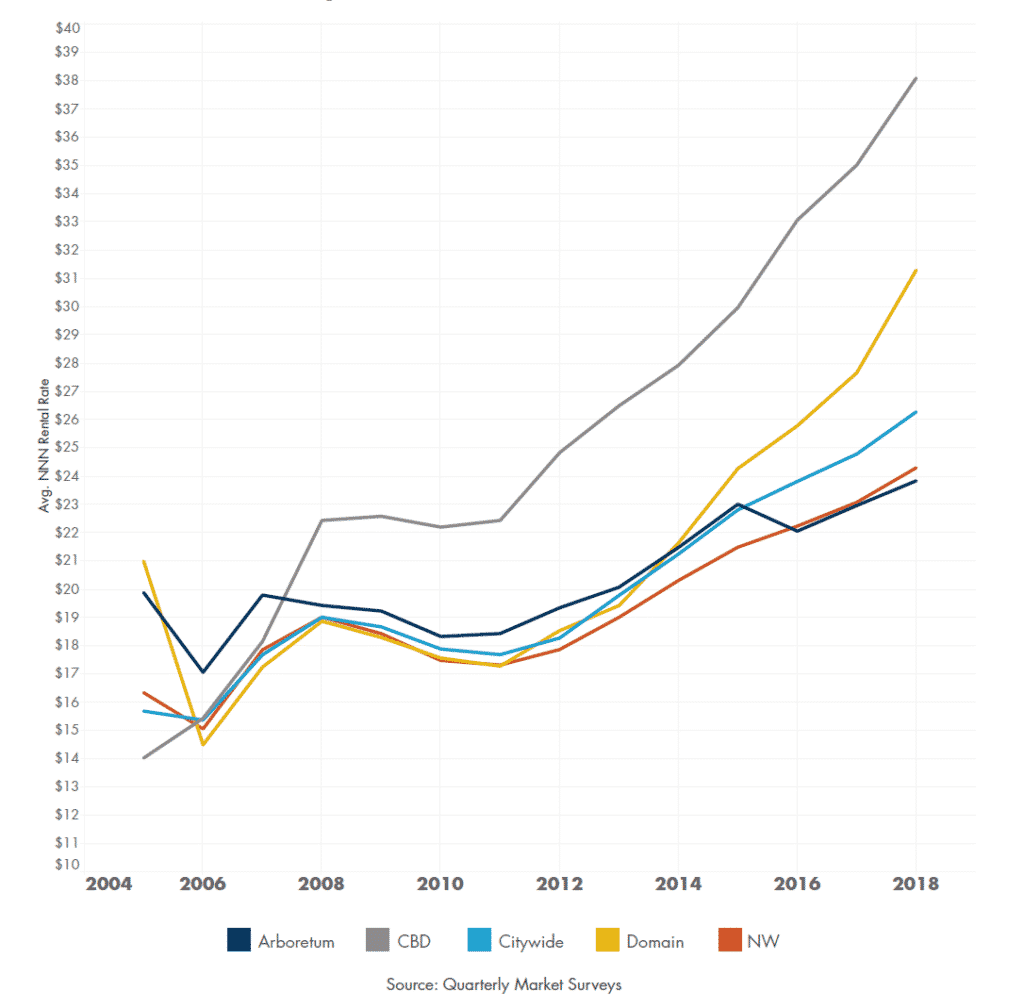
Competitive Set NNN Rental Rates
Rental rates in The Domain have far outpaced citywide rate growth since 2008 (66% vs. 38%), and very closely tracked rate growth in the CBD. Rates in The Arboretum, conversely, not only grew less than citywide rates (23% vs. 38%) but also grew less than rates in the NW submarket (23% vs. 28%).
Office tenants wishing to locate in the Northwest are clearly willing to pay more for space in The Domain, while The Arboretum presents an opportunity to secure high-quality space at a slightly lower price.
The Future of Northwest Austin, The Domain, and The Arboretum
The Arboretum/Domain micromarket has captured a lot of headlines recently, and rightfully so. If all goes to plan, this market could become even more of a bright spot in the Austin commercial real estate market in the near future.
MLS Soccer Stadium
Perhaps the most well-known development in this micromarket is the proposal for a brand new, $200 million soccer stadium at a site known as McKalla Place, an area just south of The Domain. This stadium, which has been met with harsh criticism along with avid support, was recently approved by the Austin City Council in a seven to four vote.
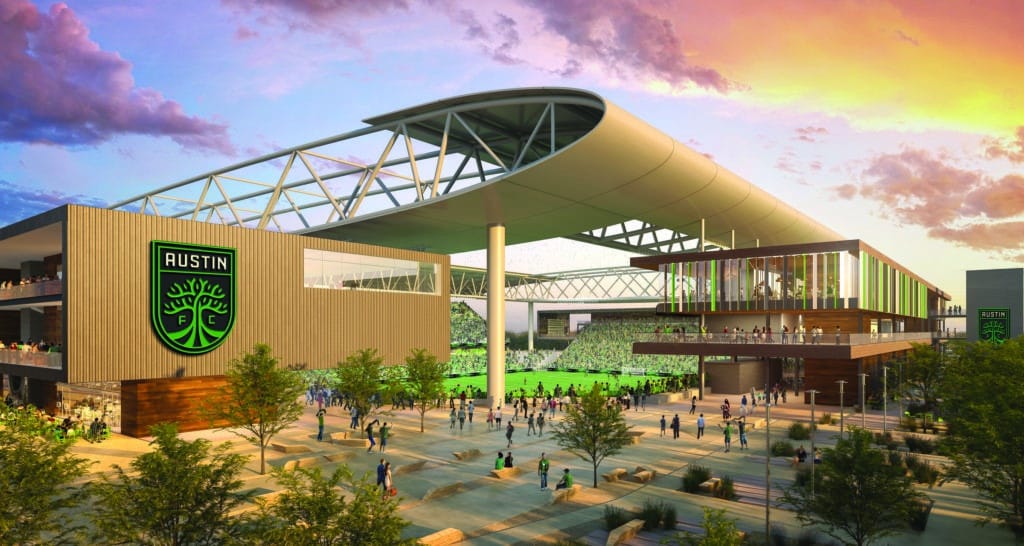
A rendering of McKalla Place, the new MLS soccer stadium just south of The Domain which will be home to Austin FC.
The stadium would be an encouraging step towards bringing CapMetro closer to this micromarket, as part of the agreement for the development specifies the stadium will have to pay $3.64 million to CapMetro to accommodate the transportation needs. Considering the current plans for the stadium include no parking, this will be an essential aspect of the entire project.
Broadmoor Campus Redevelopment
On the office space front, the Broadmoor campus redevelopment holds the potential to completely reshape the Northwest submarket. Located adjacent to The Domain, this site was rezoned by the city in June 2018 to allow for taller, denser development, opening the doors for a potential mega-development. Brandywine, which is in charge of the development, already has plans for 6 million square feet of development across 16 city blocks, connected by 23 miles of trails and a potential light rail stop.

A rendering of the Broadmoor campus, a redevelopment that holds the potential to completely reshape the Northwest submarket.
Incorporating the rail station is an essential part of the development if it is to reach its full potential, as the city has made the new density bonuses subject to a new rail stop being put in place. The details surrounding how this station will be funded and exactly how it will play out are still not quite clear, but if all goes to plan it is very likely commuters will have better direct access to offices in both the Broadmoor campus and The Domain.
What It All Means
The Arboretum/Domain micromarket is an exciting area for everyone; Austinites have access to extensive shopping and entertainment options, real estate professionals continue to be impressed by the deals being struck in the area and tenants have the chance to get the “downtown feel” without the downtown prices. With all the planned development in the works and new announcements coming out each quarter, there is no doubt we will revisit this micromarket in a future analysis.
If you would like to learn more about the Austin real estate market, download your free copy of our Austin Office Market Report.
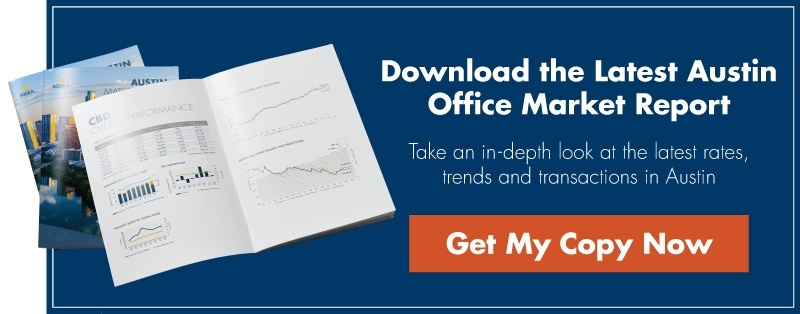
Popular Articles:
- Office Pre-Leasing and Speculative Development Trends in Austin, Texas
- How Office Density Trends Impact Commercial Building Design
- 3 Reasons Austin, TX is One of the Most Innovative Cities in the U.S.
1Source: Esri
2Source: Costar





